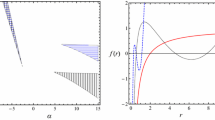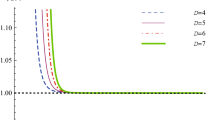Abstract
It is shown that the complete system of classical gravitational equations for an isolated centrally symmetric body yields that: (1) in terms of Galilean coordinates all metric coefficients of the Riemannian space induced by the body cannot be equal to zero or infinity anywhere; (2) they, together with the first-order derivatives, should be continuous everywhere. The equations do not contain solutions corresponding to “black holes,” but admit solutions corresponding to objects for which the surface radius (in terms of standard coordinates) is equal to the double mass of matter under this surface. These objects can make the main contribution to the dark matter of the Universe and explain observed effects, such as gravitational microlensing and other effects. Under certain conditions they can become powerful X-ray sources.
Similar content being viewed by others
References
A. M. Cherepashchuk, Priroda, 10, 16 (2006).
C. Alcock, C. W. Akerlof, R. A. Allsman, et al., Nature, 365, 621 (1993).
A. V. Byalko, Astron. Zh., 46, 998 (1969).
B. Paczynski, Astrophys. J., 804, 1 (1986).
A. M. Cherepashchuk, Vestn. Mosk. Univ., Ser. Fiz., Astron., 2, 62 (2005).
V. A. Il’in, V. A. Sadovnishii, and Bl. Kh. Sendov, Mathematical Analysis (Nauka, Moscow, 1979) [in Russian].
Ya. B. Zel’dovich, JETP, 42, 641 (1962).
A. Einstein, Collected Scientific Works, vol. 2, 514 (Nauka, Moscow, 1966) [in Russian].
S. Weinberg, Gravitation and Cosmology (Wiley, 1972; Moscow, 1975).
V. A. Fock, The Theory of Space, Time and Gravitation (Moscow, 1961; Macmillan, 1964).
A. Einstein, Collection of Scientific Papers, vol. 1, 227 (Nauka, Moscow, 1965) [in Russian].
Yu. M. Loskutov, Vestn. Mosk. Univ., Ser. Fiz., Astron., 4, 19 (2003).
Yu. M. Loskutov, Vestn. Mosk. Univ., Ser. Fiz., Astron., 3, 18 (2006).
A. A. Logunov and M. A. Mestvirishvili, Relativistic Theory of Gravitation (Nauka, Moscow, 1989) [in Russian].
C. Fronsdal, Suppl. Nuovo Cimento, 9, 416 (1958).
J. K. Barnes, J. Math. Phys., 6, 788 (1965).
Ya. B. Zeldovich, Dokl. Akad. Nauk SSSR, 155, 67 (1964).
E. E. Salpeter, Astrophys. J., 140, 796 (1964).
A. M. Cherepashchuk, Usp. Fiz. Nauk, 173, 345 (2003).
M. B. Bogdanov and A. M. Cherepashchuk, Astron. Zh., 79, 693 (2002).
M. B. Bogdanov and A. M. Cherepashchuk, Astron. Zh., 81, 291 (2004).
A. F. Zakharov and M. V. Sazhin, Usp. Fiz. Nauk, 168, 1041 (1998).
Author information
Authors and Affiliations
Additional information
Original Russian Text © Yu.M. Loskutov, 2009, published in Vestnik Moskovskogo Universiteta. Fizika, 2009, No. 2, pp. 3–9.
About this article
Cite this article
Loskutov, Y.M. About “black holes” and dark matter. Moscow Univ. Phys. 64, 103–109 (2009). https://doi.org/10.3103/S0027134909020015
Received:
Published:
Issue Date:
DOI: https://doi.org/10.3103/S0027134909020015




